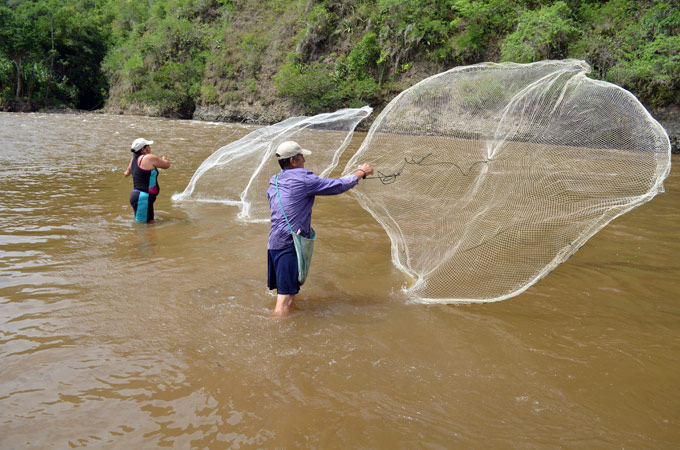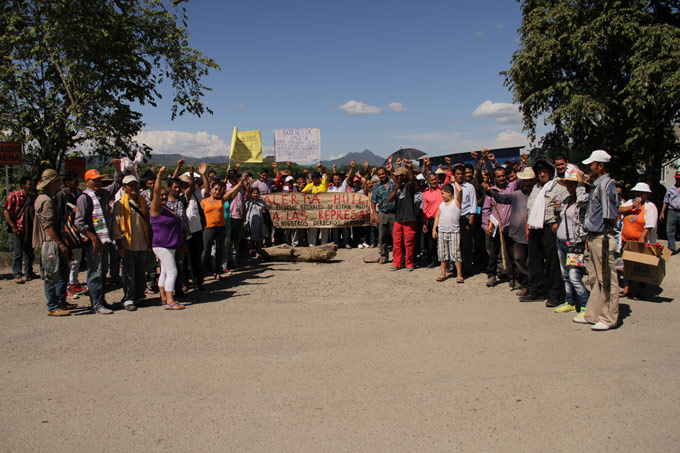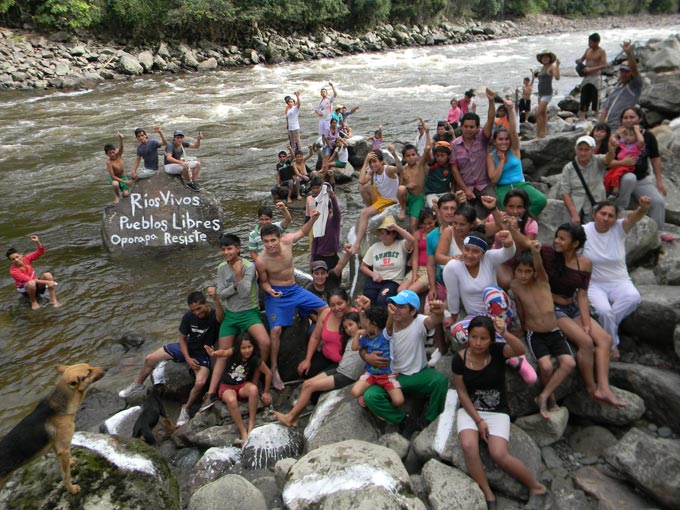In an attempt to maintain the profits of an unsustainable consumer economy, global corporations are vying for access to ever-greater shares of the earth’s limited resources, contributing to the rapid acceleration of the global climate crisis. This has been acutely felt in the mountainous southwest region of Colombia, where extraction industries threaten a vast territory of food production, unique archaeological sites, a vibrant living culture and vulnerable ecosystems.
In 1989 the Betania Dam was built in the department (as Colombia’s 32 state-like subdivisions are known) of Huila, becoming the first dam over Colombia’s principal river, the Magdalena. Its completion resulted in the flooding of more than 7,000 hectares and the displacement of more than 500 residents (PDF), for which the government offered no compensation. In recent years Colombia has privatized the entire Magdalena River, with plans to build another nine dams that will transform the upper part of the river—which flows northward from the departments of Huila and Tolima—and bleed the country of its agricultural heritage and environmental resources. In 2014 the government also gave the green light for the controversial technique of hydraulic fracturing, or “fracking,” throughout the country, including in 16 municipalities in Huila.
Pericongo is one of the sites proposed for dam construction as part of the Master Plan for the Exploitation of the Magdalena River. It is said that at this site La Gaitana, a Yalcon Indigenous woman leader who resisted Spanish Colonization, jumped to her death to avoid being captured by the Spaniards in 1540. Courtesy of Jaguos por el Territorio.
More than 200,000 Colombians have been displaced by dams and resource-extraction projects, according to the Ríos Vivos movement’s report at the 153rd session of the Inter-American Court of Human Rights in 2014. Nearly 30 years after the Betania Dam’s construction, the Quimbo Hydroelectric Project, owned by Emgesa—a subsidiary of the Spanish-Italian energy giant Endesa-Enel—is on the verge of being completed. It is expected to flood 8,500 hectares of fertile land and tropical dry forest ecosystems. And in Huila many of the families displaced by the Betania Dam are now facing a second relocation, with the filling of the Quimbo reservoir scheduled to start in June 2015. The communities that will be flooded—such as Escalereta, Balseadero and San José de Belén—have been dealing with forced evictions since 2012.

Zoila Ninco and Alvaro Cabrera continue to fish in the Magdalena River at the beach of Las Peñas in the town of La Jagua, despite Emgesa blocking access to this beach with guards and dogs. November, 2014. Courtesy of Jaguos por el Territorio.
The privatization of territory goes hand in hand with the militarization of everyday life. Once publicly accessible territories are now guarded by the national army and private security forces, making them off-limits to local inhabitants. The Magdalena River formerly provided food, work and recreation for entire families, who have lost access to fishing areas, beaches for gold panning and productive riverbanks where communal and informal subsistence crops grew. Furthermore, the productive farmland where many locals worked as day laborers has been bought by Emgesa to deforest in preparation for flooding or to develop for resettlement. This has led to widespread unemployment since 2009, triggering conflicts between resettled and unemployed communities and endangering the region’s food sovereignty.
Opponents of El Quimbo have been profiled, followed and threatened by undercover police
Thousands of people from central Huila—including fisherfolk, farmers, academics, artists and activists—have bravely organized and struggled against the Quimbo Hydroelectric Project and other extractive industries for more than five years, using tactics such as class-action lawsuits, road blockades, theatrical productions, public discussions and peaceful protests. Legal actions include a complaint with the Supreme Constitutional Court of Colombia, which in February 2013 ruled in favor of the community members, ordering Emgesa to undertake a new census of residents affected by El Quimbo. In November 2014 the community demanded the immediate cessation of construction and called for the cancellation of the project’s environmental license, which was issued in 2009, in a contempt proceeding set to receive a response in the next couple of months. In early February 2015, in response to a demand filed by the fishing industries operating in the Betania reservoir, the Administrative Court of Huila issued an emergency injunction to temporarily freeze the filling of El Quimbo’s reservoir, scheduled for June 2015, until the optimum river flow rate is met. The court’s mandate stipulates that the optimum river flow is four times the rate provided in the environmental license.
Direct actions that have emerged from the communities, such as weeklong road and construction blockades, have been violently dissolved by riot police, resulting in long-lasting physical and psychological injury among protesters. Opponents of El Quimbo have been profiled, followed and threatened by undercover police, while local corporate media have accused them of standing against progress and faking injury in order to receive compensation.

Construction workers, sub-contractors and community members block construction of El Agrado bridge, part of El Quimbo’s infrastructure. Blockades lasted 25 days in different locations in Huila. November 14, 2014. Courtesy of Jaguos por el Territorio.
Despite the threats posed by police and paramilitary forces, communities have effectively recovered farms that were bought and abandoned by Emgesa and made them productive again. From April to October 2013 more than 50 families from the community of La Jagua liberated approximately 200 hectares of the farms of La Guipa and La Virginia, investing their own money and labor to produce food for themselves and the local market. In effect, they proved that the concept of a zona de reserva campesina (peasant farmer reserve zone) is a viable alternative to flooding and displacement.
When we insist on the value of community and everyday activities, the human body becomes a political tool for territorial defense against global industrial giants
Peasant farmer reserve zones were constitutionally sanctioned in 1994 as a mechanism to regulate the use of vacant land, preventing inequitable concentration of land ownership and giving preference to resource-poor farmers in its allocation. In the 1990s six communities founded government-recognized reserve zones in the departments of Guaviare, Caquetá, Bolívar, Putumayo and Cundinamarca. But after Álvaro Uribe became president in 2002, and continuing today under Juan Manuel Santos, not a single one of the more than 30 communities that have since tried to constitute themselves as peasant farmer reserve zones have been recognized by the state. The government’s response to a proposal by La Guipa, for example, was a brutal eviction with riot police and trained dogs, using heavy machinery to destroy all the communal crops.

Community members of the town of Oporapa and Paraguay village have started to organize after witnessing the effects of the El Quimbo dam project. Oporapa is one of the 15 sites considered for dam development in the Master Plan for the Exploitation of the Magdalena River. Here residents of Oporapa paint messages of resistance along the Magdalena riverbank. August, 2014. Courtesy of Jaguos por el Territorio.
In Huila resistance is taking shape as farmers bind themselves to their land. Communities are struggling against displacement by following the paths of their ancestors and engaging with the life of their surroundings: the river’s roar, the mountain’s breath and the songs of the birds. The continuation of traditional activities tied to the Magdalena River’s geography—such as fishing, farming and gold panning—is a means of fighting imminent expropriation. When we insist on the value of community and everyday activities, the human body becomes a political tool for territorial defense against global industrial giants.
This piece was made possible by Hivos, an international organization that seeks new solutions to persistent global issues with incisive projects against discrimination, inequality, abuse of power and environmental degradation.

